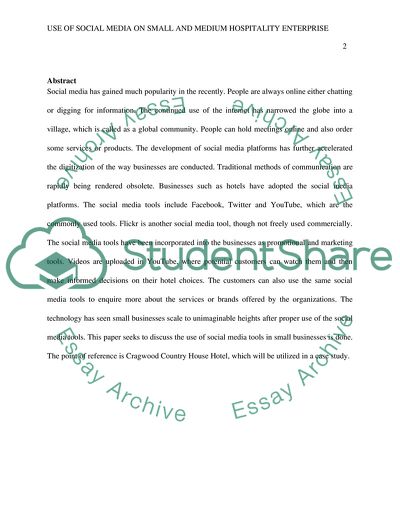Cite this document
(Use of Social Media on Small and Medium Hospitality Enterprise Research Paper, n.d.)
Use of Social Media on Small and Medium Hospitality Enterprise Research Paper. https://studentshare.org/tourism/1853653-critically-evaluate-the-use-of-social-media-on-small-and-medium-hospitality-enterprise-smte-or-a-small-destination-use-one-case-study-to-create-a-new-detailed-social-media-strategy-for-your-chosen-smte-or-small-destination
Use of Social Media on Small and Medium Hospitality Enterprise Research Paper. https://studentshare.org/tourism/1853653-critically-evaluate-the-use-of-social-media-on-small-and-medium-hospitality-enterprise-smte-or-a-small-destination-use-one-case-study-to-create-a-new-detailed-social-media-strategy-for-your-chosen-smte-or-small-destination
(Use of Social Media on Small and Medium Hospitality Enterprise Research Paper)
Use of Social Media on Small and Medium Hospitality Enterprise Research Paper. https://studentshare.org/tourism/1853653-critically-evaluate-the-use-of-social-media-on-small-and-medium-hospitality-enterprise-smte-or-a-small-destination-use-one-case-study-to-create-a-new-detailed-social-media-strategy-for-your-chosen-smte-or-small-destination.
Use of Social Media on Small and Medium Hospitality Enterprise Research Paper. https://studentshare.org/tourism/1853653-critically-evaluate-the-use-of-social-media-on-small-and-medium-hospitality-enterprise-smte-or-a-small-destination-use-one-case-study-to-create-a-new-detailed-social-media-strategy-for-your-chosen-smte-or-small-destination.
“Use of Social Media on Small and Medium Hospitality Enterprise Research Paper”. https://studentshare.org/tourism/1853653-critically-evaluate-the-use-of-social-media-on-small-and-medium-hospitality-enterprise-smte-or-a-small-destination-use-one-case-study-to-create-a-new-detailed-social-media-strategy-for-your-chosen-smte-or-small-destination.


